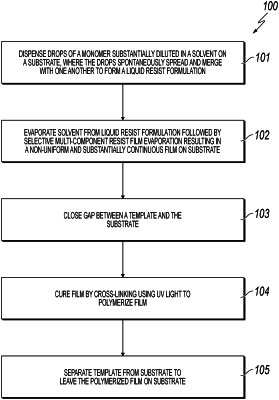| CPC G03F 7/0002 (2013.01) [B82Y 40/00 (2013.01); G01Q 60/24 (2013.01)] | 16 Claims |

|
1. A method for fabricating patterns on a flexible substrate in a roll-to-roll configuration, the method comprising:
implementing an inverse optimization scheme to determine process parameters used to obtain a desired film thickness profile of a liquid resist formulation;
covering said flexible substrate in said roll-to-roll configuration with a substantially continuous film of said liquid resist formulation, using one or more of the following techniques: dispensing discrete drops of a monomer on a substrate using an inkjet and allowing said dispensed drops to spontaneously spread and merge to form said substantially continuous film of said liquid resist formulation, slot-die coating, dip coating, gravure coating and knife-edge coating, wherein said liquid resist formulation is diluted in a solvent on said substrate, wherein one or more process parameters of said one or more techniques are determined from said inverse optimization scheme;
evaporating by heating said solvent substantially from said liquid resist formulation forming a film;
closing a gap between a template fabricated with nano-scale or micro-scale patterns and said substrate to fill features of said template with said film;
curing said film to polymerize said film; and
separating said substrate from said template leaving said polymerized film on said substrate, wherein said liquid resist formulation, whose solvent has already been evaporated, is selectively evaporated to form said film with a profile to match the desired thickness profile prior to closing said gap between said template and said substrate.
|